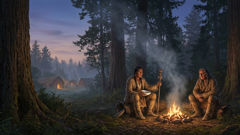Introduction
The northern edges of Ecuador’s Amazon are a place of thick green breath, where the day leans into dusk like a creature easing into sleep. In the villages that fringe the forest, the line between human lives and the wild is thin and often crossed; elders talk of rivers that carry gossip, trees that remember, and animals that watch without surprise. Among these stories the Tunda is one of the last to be told in full, saved for intimate nights by lantern light or for the hush between the tapir's call and the rain. To hear the story is to sit close to someone who remembers hunger and love, loss and the exact way the forest smells after a long dry season breaks. The Tunda is not merely a monster with fangs and claws. She is a presence that wears faces, borrows voices, and moves with the slow cruelty of a tidal pattern that has learned to mimic longing. She lives in the memory of people who have walked away, in the names whispered and in the echoes between trunks of ceibo and shihuahuaco. When a child goes missing, when a lover wanders past the last light into the palms, when a hunter takes too long, the story of the Tunda is the explanation and the warning. Yet the story is also threaded with tenderness: the Tunda often appears with the face of someone beloved, a brother, a mother, a long-dead partner. In that imitation there is grief made dangerous. The folktale that travelers call eerie and tourists call exotic is, in the villages, a way of naming how memory and the jungle can conspire to pull a person from safety. This version blends those quiet warnings with the living textures of the rainforest—the slippery mud, the sudden chorus of frogs, the swollen river that looks black in moonlight—and aims to walk the reader slowly into the folklore itself. As the narrative unfolds, you will meet the people who remember the Tunda most closely: a midwife whose husband never returned, a boy who followed a voice that sounded like his sister, an old teacher who gathered stories like seeds. You will learn how the Tunda moves when the wind stops, how she answers in the dialect of an absent heart, and how a few stubborn rites—simple words, a rope, a fire—sometimes keep the living safe. This tale is not a neat moral with a tidy end. It is a skein of human yearning and forest law, a living folktale that folds into the daily rhythms of the Amazon and asks the reader to listen closely to voices in the dark and to the way the jungle keeps its own counsel.
Voices in the Canopy
The first time Mateo heard his sister's laugh in the forest it was nothing like the sound that comes from a throat warmed by sun and broth. This laugh carried distance like a stone carries ripples: it expanded outward until Mateo felt its edges against his skin. He had been returning from the mandioca fields, a basket of tubers balanced on his hip, his feet splashing through mud cooled by a sudden rain. He had been complaining to the sky about a bad harvest when the laugh came: the exact pitch of Lucía, his sister, who had left the village a year before to work in the city. For a heart that has a particular memory, mimicry can be a knife; it opens a place inside that was not made to be reopened.

Mateo froze and tightened his grip on the basket. The laugh came again, this time closer, threaded with the rustle of leaves. It was harmless, the laugh—too innocent to be the alarm he felt unfurling in his chest. He called back, simple enough, as if speaking to any neighbor. He called Lucía's childhood name, the nickname used when the two of them had made mischief together on the riverbank. The answer mattered: half of him expected a human reply, a voice rubbing city dust from her throat, contrition in every syllable. Instead the forest returned a stillness that tasted like iron. Then a voice, like a lantern suddenly ignited, answered. It sounded like Lucía but held a delay, a precision that no one could have reproduced. The vowels rounded as she would round them when she was pleased; the consonants were too soft, like bark worn thin by the river.
This pattern—voice, hesitance, lure—appears in every telling of the Tunda. The creature does not shout or snarl. She whispers, replicates, and waits for the heat of recognition to do the rest. In some stories she is feminine, in others she is ambiguous; in many the Tunda's favored disguise is a face from one's past, a person whose absence left a vacuum. The forest itself is a collaborator: it hides breaks in the trail with new growth and lifts scents on currents to confuse the traveler. In the village, elders say the Tunda walks at a pace designed to misplace time. She will speak the name of someone you miss or call children by pet names that have been soft in your mouth since infancy. The goal is less to force and more to seduce—because what the Tunda wants most is for the living to walk toward their longing.
Not every encounter ends in loss. There are accounts of returned wanderers, hollow-eyed but alive, who claim they suffered illusions so vivid they could not be trusted afterward. Some returned because they recognized a detail the creature could not reproduce: the crooked seam in a shirt, the particular callus on a thumb, an old tooth missing. Others were saved by community practice—folk actions like tying a blue thread around the wrist, placing an offering at the trail’s fork, speaking a name three times to the river to call its truth. These protective actions are not mere superstition; they are codified knowledge passed down to distinguish mimicry from memory. There is psychology braided through the myth: grief and longing are vulnerabilities exploited by the forest’s rhythms. The Tunda's success depends on them.
Consider Carmen, the midwife whose husband never returned from a hunting trip. She had waited for months, then years. When voices in the trees began to sound like his whistle, she told the neighbors not to answer. The Tunda tested her first, letting a distant, gentle whistle move like wind through the palms. Carmen felt the old grief ache and sat as if pinned. The whistle came closer, then stopped. A small child in the compound cried out and the whistle reacted, returning a bright imitation. Carmen stood, walked to the doorway and called the man's real name, but she did it with the knowledge elders had taught: she put a hand to her mouth and did not reply to the forest; instead she lit a small bundle of fragrant leaves to scatter the scent. The Tunda, deprived of the easy warmth of response, changed face. She showed Carmen the silhouette of the missing man and then, when the smoke tasted of burned memory, she recoiled. Carmen's neighbor claims the thing hissed and vanished into the black.
Storytellers prefer to keep the Tunda's motives nearly invisible. Some say she is punishment incarnate, a guardian of the jungle that punishes those who take more than they need. Others argue she is the loneliness of the forest personified, a being that has learned to walk human paths because she shears those paths of the people who once walked them. In many variations, the Tunda is also a mirror for human error. When a lover or child is taken by the Tunda, it is often because someone ignored a warning—a rope untied, a lantern extinguished, a promise broken. The Tunda's attacks therefore become moral parables wrapped in the fog of the rainforest: care for those you love, respect the border between village and wild, keep the fire alive. But beneath the morals lies a simpler truth: the jungle remembers what we forget, and it can make forgetting into a trap.
The Tunda is also described as cunningly ordinary. She will not only mimic voices but small gestures. One man said she tied his shoelace in the exact knot his dead father used to use. Another told how she hummed a lullaby that his mother warbled into his ear until sleep carried him into the undergrowth. The creature's skill is not limited to sound; she arranges scenes that trigger memory. A hand-sewn quilt left on a stump, a basket of plantains arranged as it had been in the house, a scraped bowl—each detail deepens the illusion until the traveler can no longer tell which impulse is their own. The village children are taught an old rhyme to hum when the forest sounds too human. The rhyme is simple, nonsensical, and designed to be foreign to the Tunda's familiars: its odd cadences and meaningless images break the mirror the creature holds up.
When the story crosses into towns visited by outsiders, it becomes a tourist parable: a caution about staying on trails and not chasing voices in the dark. But in the villages, the Tunda is also a teacher of communal memory. To prevent loss, neighbors patrol the paths at dusk, calling names aloud and checking that the people who reply are truly human. Ropes are knotted in particular ways to mark safe boundaries. Offerings are placed at the trunk of great trees as a bargain—leave our people, take our waste. Folklorists traveling to Ecuador's Amazon record dozens of variations on these rituals, and each tells the same essential truth: the Tunda thrives on secrecy and exploitation of longing, but communities survive through shared vigilance and a refusal to let memory become solitary hunger. In that way, the tale is less monstrous than it is a blueprint for living with the dark's temptations.
Long-time residents will tell you the Tunda prefers certain seasons. When the rains begin in earnest and the trail markers are hidden under new leaves, the canopy hums differently; the air is thick with insect complaint and the forest's breathing. It is then the Tunda moves with better camouflage. She takes on the absence you carry—someone who left for the city, someone who drowned in the river, someone who never returned from a market—and she fashions that person like a glove. To resist her, the elders say, you must not go alone, you must not follow at the sound of your grief, and you must keep the forest's own languages handy: songs, names, the barkcutters' chant. These are practical responses to a living threat, but they are also rituals of the imagination: disciplined acts against private hallucination. The Tunda begins where solitude and memory meet; the remedy is company, story-sharing, and small public acts that tether you to the community.
The Ways to Keep a Name
If the Tunda works by borrowing faces and voices, the simplest defense is a collective one: keep each other's names in the open. In the highlands and lowlands of Ecuador, people do not always use official names. They use pet names and rituals of address stuffed with affection and history. These private names are weapons against the Tunda because the creature can replicate surface recognition—the sound of a voice, the cadence of a laugh—but she struggles with intimacy that is wound through small physical details. A nickname with a story attached becomes a test. When a neighbor calls out a familiar nickname across the trail at dusk, the answer must come from a living throat whose breath matches memory. If the voice hesitates, someone responds by naming the person's full lineage: first name, mother's name, father's name. The Tunda, folklore claims, cannot carry the burdens of lineage with the same warmth that a living family shoulder manages. She can imitate the sound of a laugh but not the weight of a family's name when it is spoken with the rolling consonants of those who belong to a particular place and history.

This emphasis on naming is not only practical but cultural. Names in many Amazonian communities are not simply labels but little narratives. They remember births, harvests, mishaps. They encode kinship and caution. Calling someone by their full name is to root them in community, to make an audible knot that the Tunda must untie to carry a person off. In older tales, when someone was tempted by the Tunda's imitation, an elder would respond by telling a story about the person—something specific and small: the exact scar on their thigh from falling out of a mango tree, the way they always mend a broken pot with sticky brown clay, the time they gave a stranger a pinch of salt. The Tunda could mimic but could not reconstruct narrative. That inability is the key exploited by the living.
Beyond names, the Tunda is countered by things the creature cannot easily reproduce: the smell of a home kitchen, the sound of a pot lid scraped against a mortar, the rhythm of a particular footfall on the porch. In one village, the remedy was a simple clattering: neighbors were taught to carry small rattles and, at dusk, to make a slow steady noise as they passed. The sound signaled presence, community, and continuity. The Tunda, whose art depends on manufactured intimacy, is disturbed by the sameness of the rattle because it announces company. These acoustic signals are communal technologies, small sonic fences that protect people not through violence but by the assertion of companionship.
Young people often challenge the old restrictions as superstition. They will leave the light at dusk and walk alone to the river to smoke a cigarette and speak to the dark. The Tunda story, in their minds, belongs to the past. Yet there are cautionary tales specifically for youth—stories of boys who went to look for a sister who had gone to the city and never returned; of lovers who followed a voice that called them away from safety. These narratives do not always end in death. Sometimes they end in the painful knowledge that the city has its own kind of Tunda: a faceless promise that imitates belonging and leaves you wanting. The parallel—between the seductive illusions of the forest and of urban life—is why the Tunda remains relevant to later generations. The monster is less a monster and more a mirror of human vulnerability across contexts.
Certain contested versions of the tale speak of the Tunda as a guardian spirit who punishes the careless but protects the respectful. In these accounts the Tunda is a boundary enforcer: she forbids night travel to protect people from the jungle's more indifferent threats (venomous snakes, disorienting rivers), and she preys upon those who break community rules. That reading allows communities to interpret the legend as part of an ecological ethic. The Tunda becomes a mythic enforcement of sustainable behavior—do not take up more land than is safe, do not travel alone at night, respect the spirits of places that sustain the village. Folklorists and anthropologists have pointed out that such narratives can function as social regulation and as a repository for local ecological knowledge. In this way the Tunda, wild and terrifying, is also an ally in disguise: a storytelling mechanism that conserves communal practices and, by extension, the land itself.
There are also accounts of curious compassion. In one telling an old woman known to many as Doña Marta would go into the forest at dusk and call out the names of those who had been lost. She would sit with a small bundle of bread and the leftover coffee grounds and offer them at a tree stump. People said she had learned a different kind of negotiation with the Tunda: do not mock her, do not challenge her like a thief; instead, treat her as a grief. Doña Marta's practice suggests the possibility of relationship rather than simple antagonism. The Tunda in this version is less a predator than an agent of sorrow that must be placated. Whether this reading is an apology for the creature or a practical ritual of healing depends on the listener, but it points to a central complexity in these legends: the forest is not simply external evil but a field of feeling where human emotions are sometimes mirrored and sometimes amplified.
Practical survival skills are woven into the folktale as well. When hiking beyond the trail, elders advise carrying a bright cloth to wave at the first sign of a sound that asks your name; the bright color interrupts the Tunda's mimicry by adding an uncomfortably vivid stimulus the creature cannot easily integrate. Another tip: do not answer calls from people who use unusual terms of endearment or who ask you to drop something you should not leave. The act of leaving behind what is essential—your companion, your martial tool, your path marker—creates a structural vulnerability. The Tunda's artistry is evolutionary: she exploits predictable human behaviors—dropping a lantern to help someone, stepping away from the group to respond to a voice—and turns obligation into trap. These practicalities, while simple, are enough in many tales to prevent disappearance.
The Tunda story grows still stranger in accounts where the creature is seen in daylight. In these rare sightings a woman-like figure will appear at the river's edge, combing her hair with a bone comb, humming a lullaby that sounds like thunder far away. Witnesses cannot say whether she is a trick of heat or an agent with intent. She is often described wearing plantain leaves or a garment stitched from moth wings—an attire that is both beautiful and grotesque. When approached by a group, she sometimes dissolves into birds or into a small swirl of leaves, leaving behind only the sense that something close to home has become not-home. The imagery lingers: the Tunda as a metamorphosis of desire, a living allegory of how nature remakes what humans think they own.
As globalization creeps further into even the most remote places, new iterations of the Tunda story incorporate technologies: a call to a missing person’s phone that comes from an unknown number but plays the voice at the exact pitch of the missing person, a social media post that mirrors private conversation. These modern reproductions pose the same question as the forest's mimicry: how do we distinguish between the genuine and the simulated? The Tunda evolves with the means of imitation. Where once she copied laughter and footfall, now she might forge a text message with a nickname or a voice note that carries just enough warmth to be believable. In response, villages adapt old rites: rather than only calling a full lineage aloud, sometimes people leave a code phrase between family members that must be used to confirm identity. The folktale thus keeps pace with technology by teaching new ways to tether trust to context and to community.
When researchers ask villagers what the Tunda teaches them today, the answers often return to simple living principles: keep your people close, name them often, make your home a place of unmistakable signals. The story becomes a living repository for ways to coexist with a world that refuses to be domesticated. It protects through narrative, through song, through the unglamorous work of checking on neighbors, mending roofs, and keeping lights lit when storms come. The Tunda is a creature of mimicry and of consequence, but in the end she is also a protagonist of human vigilance. Stories do not prevent the forest from being dangerous, but they shape how communities respond to danger—collectively, loudly, and with the stubborn insistence that memory be shared rather than hoarded.
Conclusion
The Tale of the Tunda is not only a story about a shape-shifting spirit; it is an anatomy of longing in a landscape that remembers. The jungle obliges our memories and misuses them, turning private grief into a lure. Yet the narrative balances terror with a communal ethic: the village that speaks aloud, that shares names and songs, that keeps light and company, resists the Tunda's cunning. The monster thrives on being allowed to play on solitary wounds; the remedy is companionship, ritual, and the deliberate practice of memory as a public act. In contemporary tellings, the Tunda has adapted—sometimes appearing through phones and texts, sometimes in the hush of a market lane—but the essential lesson remains. This legend holds ecological and social implications: respect the boundary between human and wild, honor the web of relationships that keeps people safe, and treat memory as a shared currency rather than a private lure. The story persists because it answers a universal question: when something in the world calls like a beloved and asks us to follow, how do we tell the true voice from the clever echo? The villagers of Ecuador answer in their daily habits—names called across trails, rattles shaken at dusk, the small bright cloths that flash like warnings—simple acts that are also moral choices. In those choices, the Tunda meets her own limits. If you travel into the rainforest, listen to the people who have lived with the story for generations. Take their names seriously, keep your routes known, bring light, and do not follow a voice into the green simply because it sounds like someone you miss. The jungle keeps its own memory, and sometimes that memory takes a form that is dangerous to the living. The folktale of the Tunda teaches how to keep one another: by speaking names, by gathering at dusk, by refusing to let grief be a private road that leads into the dark.













